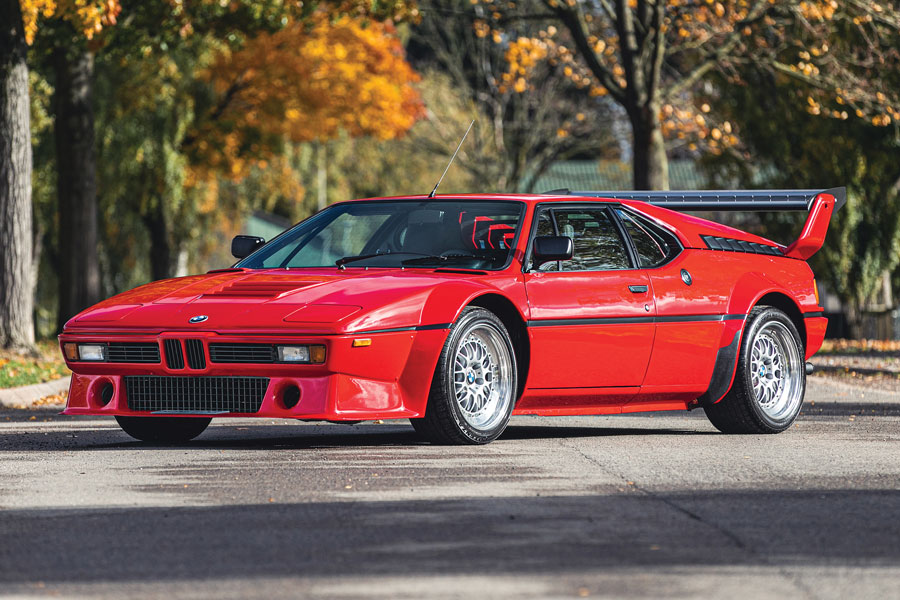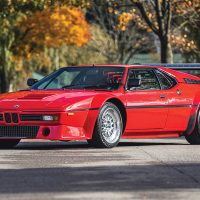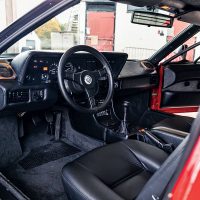SCM Analysis
Detailing
| Vehicle: | 1980 BMW M1 |
| Years Produced: | 1978–81 |
| Number Produced: | 399 (road version) |
| SCM Valuation: | $390,000 |
| Tune Up Cost: | $500 |
| Chassis Number Location: | Engine compartment (factory); door jamb and bottom of windshield (U.S. import) |
| Engine Number Location: | On top of block |
| Club Info: | BMW Car Club of America |
| Website: | http://www.bmwcca.org |
| Alternatives: | 1976–2004 Lotus Esprit, 1991–2005 Acura NSX, 1991–93 Jaguar XJ220 |
| Investment Grade: | B |
This car, Lot 450, sold for $503,912 (£382,500), including buyer’s premium, at Silverstone Auctions’ NEC Classic Live Online Auction on November 14, 2020.
Back in the late 1980s, I was giving a speech about collecting cars at a local Rotary Club. Afterwards, a member mentioned that a friend had a BMW for sale and asked if I would help him determine a value. I wasn’t interested in a sedan, but I said I’d call the gentleman and give him my opinion. When he answered the phone and told me the car he was selling was an M1, the game changed.
I bought the car sight unseen and flew to Virginia the next week to drive it back to Jacksonville, FL. To say the car was run hard and put up wet was an understatement.
The fact that I picked it up on a rainy night didn’t help matters. I had never paid that much — $65,000 — for any car in my life, but I figured it was rare enough that I could always get out of it. M1s were not built to sell in the U.S. due to DOT and EPA regulations at the time.
What had I bought?
My excitement led to a sleepless night, so I got up at 4 a.m. and headed south. Once the sun came up, I pulled off in a rest area to see just what I had bought. I was underwhelmed.
When I got home, I went by to see my friendly banker (remember them?) and as I pulled up to the bank in this white M1, some guy asked, “Is that a Ferrari?” I answered politely, “No. It is a BMW.” He answered, “I’ve never seen one like that,” to which I replied, “They are pretty rare.”
I went to lunch that day, pulling into a sandwich shop, and another man asked me, “Is that a Lotus?” To which I repeated, “No. It is a BMW.” Again, “I’ve never seen one like that,” was the reply. To which I answered, “They are pretty rare.”
Driving home, a guy pulled up at the light next to me and asked, “Is that a Pantera?” To which I answered, “No, it is a BMW.” For the third time, the reply was, “I’ve never seen one like that,” followed by me with, “They are pretty rare.”
Now, by this time, I was getting pretty tired of the question concerning just what this car was. That evening, my wife, the ever-patient Ms. Jane, and I decided to get a hamburger at a nearby Hooters. When I pulled up to the restaurant, one of the Hooters girls looked at the car and said, “Wow, an M1!”
Still a teenager, she knew exactly what it was. She had a poster tacked up on her bedroom wall at home.
You just can’t win
My white car had originally been red, but the previous owner must have got tired of saying, “No, it is not a Ferrari.” In restoring the car, I put it back to red. Shortly thereafter, while fueling at a local Shell station, the attendant walked out and asked why my Ferrari had BMW medallions on it. Sometimes, you just can’t win.
The M1 was sort of a sophisticated kit car. Gauges, door handles and taillight assemblies all came off of other production BMWs. The car was to be built by Lamborghini for BMW, but financial problems led to Baur assembling the car. The result was an Italian/German conglomeration of parts with a wonderful 3.5-liter straight 6. It only had 277 hp, but 0–60 mph in 5.5 seconds was possible, as the gearbox was pretty slick.
It had a trunk that was fairly large, and because it was located over the muffler, your shaving cream would get to a nice, warm level, while everything else just got cooked.
The assembly, fit and finish were not so hot. I had the only fiberglass door that showed rust. The steel door frames were bonded to the fiberglass door skin, which would catch water and rot out from the inside. The rusted door frame would then push its way through the fiberglass.
The leather-covered dash panels would shrink and tear, but worst of all were the Magneti Marelli electrics. If the ignition boxes went out, you had to ship them to Italy for repair. And the car ate distributor caps like candy. Never buy a German car with Italian electrics.
Parts arbitrage
I also had problems with the M1-only water pumps, which would seize up. I kept two spares on the shelf. Prices for parts here in the U.S. were astronomical, as the distributor knew you had an M1 by the part numbers and you got hosed. If I bought a water pump from a U.S. source (which I will not name to protect the guilty), it was $1,300. Yet I found a shop in Germany that would sell me one for $235. Air filters were a hundred dollars or more, and the oil filter, though similar to a Porsche 930 unit, was also pricey.
They built a lot of toe in the rear to give the car some directional stability, but this led to the M1 eating tires like a fat man eating doughnuts at a Krispy Kreme.
The air-conditioner condensation pan was centrally located under the dash and was prone to fill up with cool water, which would pour on the driver’s right foot on right-hand turns, or on the passenger’s left foot on left-hand turns.
Taking my bath
Despite all this, the car was reasonably comfortable for road trips. Jane and I drove it all over Florida, Georgia, and North and South Carolina. The sound of the inline 6 was really solid, all the way up to the redline. BMW has always made good motors.
I kept the car about 10 years and sold it to my friend (I think he is still my friend) Kelly Marsh at Kelly BMW in Columbus, OH. This is after I had spent an additional $60,000 in restoration costs. The M1 was one of the few cars I took a financial bath on. It was fun to have such a rare car, but it came at a price. C’est la vie.
At $504k, this one sold on the high side of the market. But by all accounts, it was a terrific example. Best of luck to the new owner in explaining what his new “Lamborghini” really is. ♦
(Introductory description courtesy of Silverstone Auctions.)


